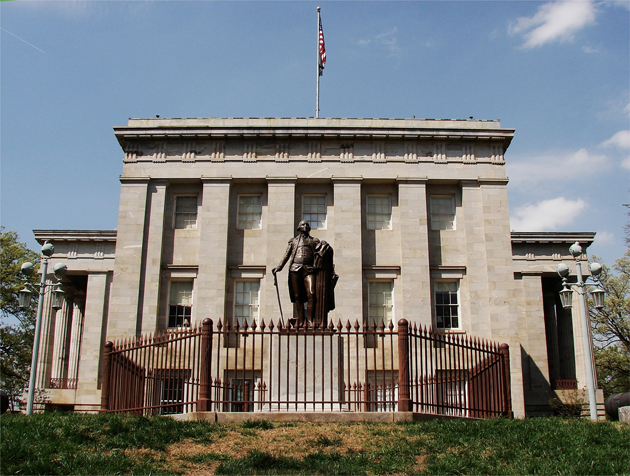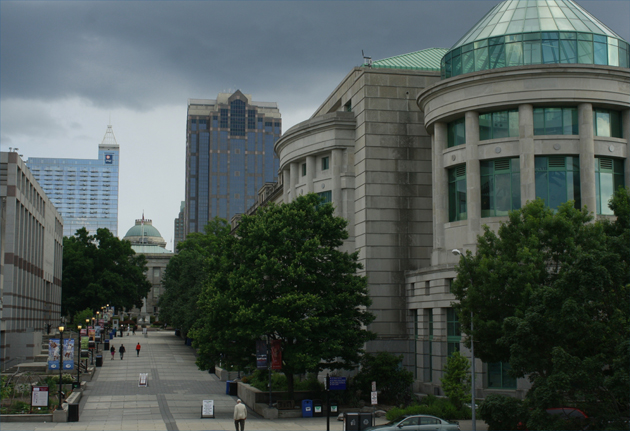Publisher's note: We believe the subject of history makes people (i.e., American people) smarter, so in our quest to educate others, we will provide excerpts from the North Carolina History Project, an online publication of the John Locke Foundation. This seventy-fifth installment, by Jonathan Martin, was originally posted in the North Carolina History Project.
The Sissipahaw and Occaneechi lived and inhabited what is present-day Wake County, and English and Scotch-Irish settlers from northern states moved into the area during the seventeenth century. Colonists started farms and small agrarian communities in Wake County in the 1730s, paralleling the agriculture upbringing of the early North Carolina colony.
The county remained primarily agricultural until the Civil War changed the economy. The railroad delivered new people and provided more resources to Wake County farmers and fledging businesses. From the 1880s to the 1910s, towns developed near railroad depots and farmers started growing different crops, and most focused on cotton and tobacco. However, with the onset of the Great Depression and eventually the end of the Second World War, Wake County, particularly the town of Raleigh, changed into the urban and industrial center which became a precursor of the present outlook of the area.
Established from the Cumberland, Johnston, and Orange counties in 1771, Wake received its name in honor of William Tryon's wife, Margaret Wake Tryon. The county's seat was created in 1771 with the name of Wake County Courthouse. Yet, in 1792 the seat became the permanent capital city of North Carolina and its name became Raleigh. The town was named in honor of the famous privateer and sponsor of the original Roanoke colony, Sir Walter Raleigh. Several other communities within Wake County include: Apex, Cary, Fuquay-Varina, Garner, Wake Forest, and Holly Springs.
William Christmas, state senator from Franklin County, first proposed the idea of incorporating Raleigh as the state capital. After the state of North Carolina bought nearly 1,000 acres from Joel Lane, plans were set in motion to build the town. At first Raleigh's growth was stunted due to fires and poor agriculture conditions, but when the railroad finally opened the city to the rest of the state, Raleigh began growing in the 1840s and 1850s. After the Civil War, Raleigh coped with Reconstruction measures, and soon both the Research Triangle Park along with Wake County's important colleges and universities bolstered the growth of the state's capitol city.
Research Triangle Park (RTP), a joint effort of many businessmen, scientists, and politicians, was created as what historian William S. Powell described as "the largest planned research center in the United States." Started in the late 1950s as an attempt to transition the economy to more modern adventures, the RTP is located amidst three of North Carolina's most renowned universities - the University of North Carolina at Chapel Hill, North Carolina State University, and Duke University - between Durham and Raleigh. Today, companies and businesses ranging from information technologies, environmental sciences, and pharmaceutical sciences have headquarters in the RTP and some of the largest industries include IBM, GlaxoSmithKline, and Nortel Networks.
 The North Carolina General Assembly then and now are both of Fayetteville Street and both are full of history. The 2nd General Assembly, here viewed looking by looking north from Fayetteville Street, exhibits, in the foreground, a robust statue of the patriarch of America, Virginian George Washington: Above. The current General Assembly, where all the sausage factory for legislation grinds on and on: Below. photos by Stan Deathearage Click on the image to expand.
The North Carolina General Assembly then and now are both of Fayetteville Street and both are full of history. The 2nd General Assembly, here viewed looking by looking north from Fayetteville Street, exhibits, in the foreground, a robust statue of the patriarch of America, Virginian George Washington: Above. The current General Assembly, where all the sausage factory for legislation grinds on and on: Below. photos by Stan Deathearage Click on the image to expand.

In regards to the political and government aspect of Wake County, the State Capitol has remained the center for North Carolina government since 1840. Although the General Assembly moved to the State Legislative Building in 1963, the State Capitol in Union Square placates itself as an important historical structure in the town of Raleigh. Classified by historian Powell as "one of the best-preserved examples of Greek Revival architecture in America," the State Capitol houses numerous statues of important North Carolina leaders and politicians including the state's three presidents - Andrew Jackson, James K. Polk, and Andrew Johnson.
 Fayeteville Street, here just a mall, this image made from the mezzanine of the NC General Assembly shooting south, connecting from north to south the two historic legislatures, with the North Carolina History Museum to the east of the mall and the newly renovated North Carolina Museum of Natural History to the west of the Fayetteville Street Mall: Above. photo by Stan Deatherage Click image to enlarge.
Fayeteville Street, here just a mall, this image made from the mezzanine of the NC General Assembly shooting south, connecting from north to south the two historic legislatures, with the North Carolina History Museum to the east of the mall and the newly renovated North Carolina Museum of Natural History to the west of the Fayetteville Street Mall: Above. photo by Stan Deatherage Click image to enlarge.
Due to its distinction as the capital county of North Carolina, Wake County boasts in its many historic places and cultural attractions. Some landmarks include the State Capitol (1833-1840), the Governor's Mansion (1891), the State Legislative Building (1961), the Joel Lane House (1760s), Mordecai Historic Park (1785), and the North Carolina State Fairgrounds. Numerous museums are found in the county including the North Carolina Museum of Art, the North Carolina Museum of History, and the North Carolina Museum of Natural Sciences. Several festivals and popular events are held in Wake County year round. Most importantly is the North Carolina State Fair and other events include the International Festival, the Today and Yesteryear Festival, and Saint Patrick's Day Parade. The notable universities within Wake County include North Carolina State University (1887), Peace College (1857), Shaw University (1865), St. Augustine's College (1867), and Meredith College (1891).
Several important politicians made their home in Wake County. Born in Raleigh, Andrew Johnson (1808-1875) became the seventeenth president of the United States after the assassination of Abraham Lincoln. Johnson had the difficult task of mending the country back together after the Civil War, and many of his policies were unpopular with Radical Republicans. Impeached in 1868, Johnson managed to elude conviction. Walter H. Page (1855-1918), Ambassador to Great Britain from 1913 until 1918, was born in Wake County a year after his father founded the town of Cary. Page organized the Watauga Club which charged the N.C. legislature to create a polytechnic institute, and North Carolina State University came about due to the club's plan. A firm supporter of Woodrow Wilson during his presidential campaign, Page became the U.S. Ambassador to Great Britain during the late 1910s. Joseph M. Broughton (1888-1949), distinguished as the only Wake County native to be governor of North Carolina, served as leader of the state during World War II. Broughton's leadership helped organize the civil defense of North Carolina, and he helped in the commission of the U.S.S. North Carolina.
Sources:
"Wake County; Research Triangle Park; Raleigh; State Capitol." William S. Powell, ed. Encyclopedia of North Carolina (University of North Carolina Press: Chapel Hill, NC 2006).
"Wake County History." Wake County Government website - The Historic Architecture of Wake County, North Carolina. Kelly A. Lally (1994).
http://www.wakegov.com/kids/history.htm, (accessed January 13, 2011).
"Walter H. Page; Joseph M. Broughton; Andrew Johnson." North Carolina Highway Historical Marker Program website. A Division of the North Carolina Department of Cultural Resources. (accessed January 13, 2011).



